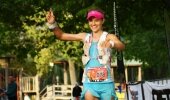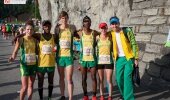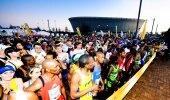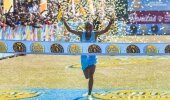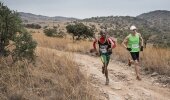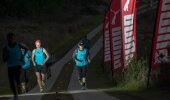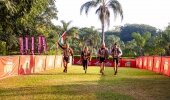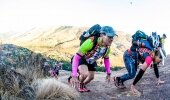Words: Press release
Cape Town, 1 July 2015 – Running a marathon can be an arduous challenge, but Sanlam Cape Town Marathon (Africa’s only IAAF accredited marathon) ambassador Elana Meyer believes anyone can achieve the feat. With the right preparation and commitment, she says every person can reap the resultant rewards.
Few people in South Africa are better equipped to offer advice on road running than Meyer, a former Olympic 10 000m silver medallist, world half-marathon champion and world record holder over 5km, 15km and 21.1km. Having set six of the eight fastest times in the SA women's all-time list over the classic 42.2km standard marathon distance, the retired athlete and Stellenbosch resident took time out to share some wisdom with those who will tackle the second Cape Town race, to be held on 20 September.
"Preparing for a marathon, the focus should be on strength, endurance and pace runs," Meyer says. "You need to be strong if you want to run a good marathon. By incorporating strength conditioning it will help you stay injury free and handle the distance a lot better. Also incorporate hill repeats. It will make you tough."
Long distance runs are key, according to Meyer, but it is not necessary to prepare purely on a tar surface. Slower distance efforts need to be included in the training regimen of every aspiring marathon runner, because time spent on one's legs is a vital part of preparation. Speed work, however, also plays a part as it will make racing more comfortable.
"Incorporate time trials, park runs or longer intervals into your programme. It will help with running economy and you will feel a lot more comfortable at marathon race pace."
Meyer offers some key tips to potential Sanlam Cape Town Marathon participants:
• Make sure you have training buddies when you sign up for the marathon. The journey will be much more enjoyable.
• If you can, do most of your runs off road.
• Follow a 12- to 16-week programme. There are training programmes on the race website (www.sanlamcapetownmarathon.com), or sign up with one of the Sanlam Cape Town Marathon coaches for on-line coaching.
• Have fun and enjoy the journey
Since the marathon was introduced to the Olympic schedule in Athens in 1896, and the official distance of 42.195km was recognised at the 1908 London Games, thousands of people have completed the historic feat first achieved by Greek war messenger Pheidippides in 500BC. By following these tips, Meyer feels anyone can do it, provided they have the right mindset and approach.
"Ideally you need to gradually build up from 10km to 21km to the marathon, but there are many people that pick a marathon as a challenge and just go for it. It depends on the individual and the personality," Meyer says.
Sanlam’s Chief Medical Advisor, Dr Pieter Coetzer says experts agree that an active lifestyle contributes significantly towards a healthy life, both in terms of longevity and improved quality of life. This makes participation in an event such as the Sanlam Cape Town Marathon as much a lifestyle choice as a personal challenge.
“Endurance sports like road running improve not only one’s physical health, but also mental health, leading to a better family and work life. Among others, it has been shown to improve memory, physical abilities, self-confidence and contributes significantly to an optimistic attitude towards life and its challenges. We believe the sport of running is easily accessible and within most people’s means. By its very nature, running requires determination, dedication and the belief that a lot can come from very little,” says Dr Coetzer.
And the benefits of exercise are not restricted to wellness: “Regular exercise improves the long term control of chronic lifestyle diseases like high blood pressure, high cholesterol, diabetes and excessive weight. The World Health Organization (WHO) estimates that physical inactivity is the main cause for approximately 21–25% of breast and colon cancers, 27% of diabetes and approximately 30% of ischaemic heart disease burden. As a result, it recommends that people between the ages of 18 and 64 do at least 150 minutes of moderate-intensity physical activity per week to reduce their risk. That is enough reason to take up the challenge and start moving."
Training for the gruelling 42km challenge is important, but other areas of preparation are just as crucial, according to Andrea du Plessis. A nutritional specialist at Vital Health Foods, the race's official development partner, Du Plessis says dietary intake can affect an athlete's training and racing ability.
"The biggest impact nutrition can make on your training programme is to help your muscles recover rapidly. This ensures getting the best value out of regular training sessions," Du Plessis says.
Nutrients that are required for recovery nutrition include:
• water
• carbohydrates
• protein (including the branched chain amino acids)
• electrolytes
• vitamins
• minerals
• antioxidants
Du Plessis urges runners to look out for two specific ingredients when selecting their training recovery nutrition formula:
• Whey protein is a source of the essential and branched chain amino acids required for muscle recovery.
• Glutamine is an important nutrient for individuals that participate in high intensity endurance training and events. It is vital for recovery after training and important for the immune system, as it is used by the immune cells located in the digestive system.
Staying hydrated is important too, before, during and after exercise. Du Plessis provides key points to avoid dehydration, which accelerates the onset of fatigue:
• Make sure to drink at least six to eight glasses of water per day to stay well hydrated.
• When exercising under warm conditions, make sure to increase your fluid intake with at least 500ml to 1 000ml on that day.
• Sports drinks taken before, during and after exercise may help keep you hydrated for training sessions that last longer than 30 minutes.
• During training, fluid intake of about 500ml per hour should be sufficient, depending on perspiration rate, which differs between individuals, and the temperature on the day.
While taking enough fluids is a wise approach, Du Plessis warns against excessive fluid intake: "This may result in over-hydration and hyponatremia, which may impair sports performance and can be as dangerous as dehydration."
When training in hot conditions, Du Plessis says it is important to replace natural salts such as sodium and potassium. Sodium is widely available in our diets and does not need to be supplemented, so potassium is more important as a focus nutrient. Rich sources of potassium include:
• guavas
• dried guava roll
• dried apricots
• tomato juice
• celery
• potatoes
• bananas
• raisins
Du Plessis also recommends an intake of healthy food sources rich in natural salts and electrolytes:
• fresh vegetables
• fresh fruits
• dried fruits.
Additionally, starchy and sweet foods provide fuel for your body in the form of carbohydrates. This is important because it transforms to glucose, which is required for muscle power during exercise. Healthy options are:
• whole-grain cereals
• whole-wheat bread
• brown rice
• pasta
• potatoes
• sweet potatoes
• corn
• peas
Finally, for immune support, Du Plessis suggests high Vitamin C intake (1 500mg supplemented per day) as well as Zinc, in order to stay healthy.
Another important aspect to consider when preparing for a long distance race is shoes and apparel. Dawid Visser, promotions and training specialist at Asics South Africa, says there are four key areas to consider when selecting training and racing kit:
• It's important to get the correct type of shoes suitable for your running style. You can go to your local specialist sports shop to get a gait assessment. Different types of shoes with specific features help support your running style and minimise injuries.
• The correct size of footwear is crucial. The wrong size can cause severe discomfort, blue toenails and even blistering.
• Running clothing needs to suit your environment and training conditions. Use vests or tech tees and shorts for warm weather, and long-sleeve tops or jackets and tights for winter training.
• Good quality comfortable socks can make your running experience much more enjoyable.
Visser warns against starting a race with a new pair of shoes. "You need to make the shoes mold to your feet to ensure proper fitting when you get to race day. This also eliminates the chances of excessive blistering," he says.
Backed with the wisdom of these experts, the organisers and sponsors of the Sanlam Cape Town Marathon are expecting a record field this year for Africa's only IAAF Silver Label race.
Coetzer says: "Sanlam wishes all participants, including the Sanlam Wealthsmiths that will run the marathon again this year, well in their preparations for the race. We hope that this will inspire many more to follow in their footsteps.”
